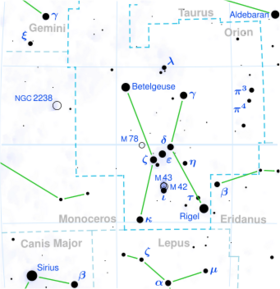29 Orionis
Topic: Astronomy
 From HandWiki - Reading time: 3 min
From HandWiki - Reading time: 3 min
| Observation data Equinox J2000.0]] (ICRS) | |
|---|---|
| Constellation | Orion |
| Right ascension | 05h 23m 56.82768s[1] |
| Declination | −7° 48′ 29.0332″[1] |
| Apparent magnitude (V) | 4.13[2] |
| Characteristics | |
| Spectral type | G8IIIFe-0.5[3] |
| U−B color index | +0.70[4] |
| B−V color index | +0.96[4] |
| Astrometry | |
| Radial velocity (Rv) | −17.68[5] km/s |
| Proper motion (μ) | RA: −14.82[1] mas/yr Dec.: −45.02[1] mas/yr |
| Parallax (π) | 20.73 ± 0.17[1] mas |
| Distance | 157 ± 1 ly (48.2 ± 0.4 pc) |
| Absolute magnitude (MV) | 0.73[6] |
| Details | |
| Mass | 2.33[2] M☉ |
| Radius | 10.36[5] R☉ |
| Luminosity | 71[2] L☉ |
| Surface gravity (log g) | 2.44[2] cgs |
| Temperature | 4,852[2] K |
| Metallicity [Fe/H] | −0.25[2] dex |
| Rotational velocity (v sin i) | 1.1[7] km/s |
| Other designations | |
| Database references | |
| SIMBAD | data |
29 Orionis is a single[9] star located around 157[1] light years away from the Sun in the equatorial constellation of Orion. In Bayer's Uranometria, this star is one of two stars (the other being Upsilon Orionis) marking the top of Orion's right boot.[10] It has the Bayer designation e Orionis, while 29 Orionis is the Flamsteed designation. This object is visible to the naked eye as a faint, yellow-hued point of light with an apparent visual magnitude of 4.13.[2] It is moving closer to the Earth with a heliocentric radial velocity of -18 km/s.[5]
This is an aging giant star with a stellar classification of G8IIIFe-0.5,[3] having exhausted the supply of hydrogen at its core and evolved away from the main sequence. The suffix notation indicates a mild underabundance of iron in the spectrum. It is a red clump giant,[11] which means it is on the horizontal branch and is generating energy through helium fusion at its core. The star has 2.33[2] times the mass of the Sun and has expanded to 10.36[5] times the Sun's radius. It is radiating 71 times the Sun's luminosity from its enlarged photosphere at an effective temperature of 4,852 K.[2]
References
- ↑ 1.0 1.1 1.2 1.3 1.4 1.5 Van Leeuwen, F. (2007). "Validation of the new Hipparcos reduction". Astronomy and Astrophysics 474 (2): 653–664. doi:10.1051/0004-6361:20078357. Bibcode: 2007A&A...474..653V. Vizier catalog entry
- ↑ 2.0 2.1 2.2 2.3 2.4 2.5 2.6 2.7 2.8 Takeda, Yoichi; Sato, Bun'ei; Murata, Daisuke (2008). "Stellar Parameters and Elemental Abundances of Late-G Giants". Publications of the Astronomical Society of Japan 60 (4): 781–802. doi:10.1093/pasj/60.4.781. Bibcode: 2008PASJ...60..781T.
- ↑ 3.0 3.1 Hoffleit, D.; Warren, W. H. (1995). "VizieR Online Data Catalog: Bright Star Catalogue, 5th Revised Ed. (Hoffleit+, 1991)". VizieR On-line Data Catalog: V/50. Originally Published in: 1964BS....C......0H 5050. Bibcode: 1995yCat.5050....0H.
- ↑ 4.0 4.1 Ducati, J. R. (2002). "VizieR Online Data Catalog: Catalogue of Stellar Photometry in Johnson's 11-color system". CDS/ADC Collection of Electronic Catalogues 2237. Bibcode: 2002yCat.2237....0D.
- ↑ 5.0 5.1 5.2 5.3 Jofré, E.; Petrucci, R.; Saffe, C.; Saker, L.; Artur de la Villarmois, E.; Chavero, C.; Gómez, M.; Mauas, P. J. D. (2015). "Stellar parameters and chemical abundances of 223 evolved stars with and without planets". Astronomy & Astrophysics 574: A50. doi:10.1051/0004-6361/201424474. Bibcode: 2015A&A...574A..50J. Vizier catalog entry
- ↑ Da Silva, Ronaldo; Milone, André de C.; Rocha-Pinto, Helio J. (2015). "Homogeneous abundance analysis of FGK dwarf, subgiant, and giant stars with and without giant planets". Astronomy & Astrophysics 580: A24. doi:10.1051/0004-6361/201525770. Bibcode: 2015A&A...580A..24D. Vizier catalog entry
- ↑ De Medeiros, J. R.; Alves, S.; Udry, S.; Andersen, J.; Nordström, B.; Mayor, M. (2014). "A catalog of rotational and radial velocities for evolved stars". Astronomy & Astrophysics 561: A126. doi:10.1051/0004-6361/201220762. Bibcode: 2014A&A...561A.126D. Vizier catalog entry
- ↑ "e Ori". SIMBAD. Centre de données astronomiques de Strasbourg. http://simbad.u-strasbg.fr/simbad/sim-basic?Ident=e+Ori.
- ↑ Eggleton, P. P.; Tokovinin, A. A. (September 2008). "A catalogue of multiplicity among bright stellar systems". Monthly Notices of the Royal Astronomical Society 389 (2): 869–879. doi:10.1111/j.1365-2966.2008.13596.x. Bibcode: 2008MNRAS.389..869E.
- ↑ Wagman, Morton (2003). Lost Stars: Lost, Missing and Troublesome Stars from the Catalogues of Johannes Bayer, Nicholas Louis de Lacaille, John Flamsteed, and Sundry Others. Blacksburg, VA: The McDonald & Woodward Publishing Company. p. 513. ISBN 978-0-939923-78-6.
- ↑ Alves, David R. (August 2000). "K-Band Calibration of the Red Clump Luminosity". The Astrophysical Journal 539 (2): 732–741. doi:10.1086/309278. Bibcode: 2000ApJ...539..732A.
 |
 KSF
KSF
